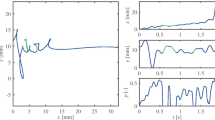Abstract
Radio Frequency Identification (RFID) has been adopted in various applications owning to its many attractive properties such as low cost, no requirement on line-of-sight, and battery-free. This paper studies the problem of RFID-based Handwriting recognition, which is practically important in Human-Computer Interaction (HCI) scenarios. To the best of our knowledge, the state-of-the-art works beget leaking user privacy, because the malicious attacker can eavesdrop on the RFID signals (e.g., tag phase) broadcast in the air and further analyze the user’s handwriting activity. To address the privacy leakage issue, we propose a secure RFID handwriting recognition system named SecRFPen to enable privacy-preserving handwriting recognition. In SecRFPen, the legal reader switches the probing frequency and power, the phase angles of RF signals reflected by the tagged pen will change accordingly. Thus, the phase profile of the tagged pen is actually determined by both reader-tag hardware characteristics and handwriting movements. We propose an authentication matrix to quantify RFID device hardware characteristics, which can be measured by legal users in advance. Thus, the legal RFID reader can recognize the handwriting activity via analytics on the authentication matrix and tag phase profile. On the contrary, since the malicious attacker knows nothing about the hardware characteristics of legal RFID devices, it cannot understand handwriting even if it can hear the tag signals. We implement the SecRFPen system based on the Commercial-Off-The-Shelf (COTS) RFID devices. Extensive experimental results demonstrate that the recognition accuracy of legal users can reach 94.2%, while the recognition accuracy of the malicious attacker is as low as 35.1%.
Access this chapter
Tax calculation will be finalised at checkout
Purchases are for personal use only
Similar content being viewed by others
References
Alam, M.S., Kwon, K., Kim, N.: Implementation of a character recognition system based on finger-joint tracking using a depth camera. IEEE Trans. Hum. Mach. Syst. 51(3), 229–241 (2021)
Ding, D., Yang, L., Chen, Y., Xue,G.: VibWriter: handwriting recognition system based on vibration signal. In: Proceedings of IEEE SECON, pp. 1–9 (2021)
Chen, M., AlRegib, G., Juang, B.-H.: Air-writing recognition–part I: modeling and recognition of characters, words, and connecting motions. IEEE Trans. Hum. Mach. Syst. 46(3), 403–413 (2015)
Wang, H., Gong, W.: RF-pen: practical real-time RFID tracking in the air. IEEE Trans. Mobile Comput. 20(11), 3227–3238 (2020)
Wang, J., Vasisht, D., Katabi, D.: RF-IDraw: virtual touch screen in the air using RF signals. vol. 44, pp. 235–246 (2014)
Chang, L., Jie **ong, J., Wang, X.C., Wang, Yu., Tang, Z., Fang, D.: RF-copybook: A millimeter level calligraphy copybook based on commodity RFID. Proc. ACM on Interact. Mob. Wearable Ubiquit. Technol. 1(4), 1–19 (2018)
Jiang, C., He, Y., Zheng, X., Liu, Y.: OmniTrack: orientation-aware RFID tracking with centimeter-level accuracy. IEEE Trans. Mob. Comput. 20(2), 634–646 (2019)
Cleveland, W.S.: Lowess: a program for smoothing scatterplots by robust locally weighted regression. Am. Stat. 35(1), 54 (1981)
**ao, X., **, L., Yang, Y., Yang, W., Sun, J., Chang, T.: Building fast and compact convolutional neural networks for offline handwritten Chinese character recognition. Pattern Recognit. 72, 72–81 (2017)
Poznanski, A., Wolf, L.: CNN-N-Gram for handwriting word recognition. In: Proceedings of IEEE CVPR, pp. 2305–2314 (2016)
Zhang, M., Li, P., Yang, P., **ong, J., Chang, T.: Poster: sonicnect: accurate hands-free gesture input system with smart acoustic sensing. In: Proceedings of ACM MobiSys, pp. 91–91 (2016)
Du, H., Li, P., Zhou, H., Gong, W., Luo, G., Yang, P.: Wordrecorder: accurate acoustic-based handwriting recognition using deep learning. In: Proceedings of IEEE INFOCOM, pp. 1448–1456 (2018)
Kaishun, W., Yang, Q., Yuan, B., Zou, Y., Ruby, R., Li, M.: Echowrite: an acoustic-based finger input system without training. IEEE Trans. Mob. Comput. 20(5), 1789–1803 (2020)
Deselaers, T., Keysers, D., Hosang, J., Rowley, H.A.: Gyropen: gyroscopes for pen-input with mobile phones. IEEE Trans. Hum. Mach. Syst. 45(2), 263–271 (2014)
Schrapel, M., Stadler, M.L., Rohs, M.: Pentelligence: combining pen tip motion and writing sounds for handwritten digit recognition. In: Proceedings of ACM CHI, pp. 1–11 (2018)
Yang, L., Chen, Y., Li, X.-Y., **ao, C., Li, M., Liu, Y.: Tagoram: real-time tracking of mobile RFID tags to high precision using COTS devices. In: Proceedings of ACM MobiCom, pp. 237–248 (2014)
Wei, T., Zhang, X.: Gyro in the air: tracking 3D orientation of batteryless internet-of-things. In: Proceedings of ACM MobiCom, pp. 55–68 (2016)
Um, T.T., et al.: Data augmentation of wearable sensor data for Parkinson’s disease monitoring using convolutional neural networks. In: Proceedings of ACM ICMI, pp. 216–220 (2017)
Acknowledgment
This work is supported in part by the National Natural Science Foundation of China under Grant Nos. 62002259, 62032017.
Author information
Authors and Affiliations
Corresponding author
Editor information
Editors and Affiliations
Rights and permissions
Copyright information
© 2022 The Author(s), under exclusive license to Springer Nature Switzerland AG
About this paper
Cite this paper
Zhang, Q., Zhang, J., Liu, X., Tong, X., Li, K. (2022). Secure RFID Handwriting Recognition–Attacker Can Hear but Cannot Understand. In: Wang, L., Segal, M., Chen, J., Qiu, T. (eds) Wireless Algorithms, Systems, and Applications. WASA 2022. Lecture Notes in Computer Science, vol 13471. Springer, Cham. https://doi.org/10.1007/978-3-031-19208-1_34
Download citation
DOI: https://doi.org/10.1007/978-3-031-19208-1_34
Published:
Publisher Name: Springer, Cham
Print ISBN: 978-3-031-19207-4
Online ISBN: 978-3-031-19208-1
eBook Packages: Computer ScienceComputer Science (R0)




